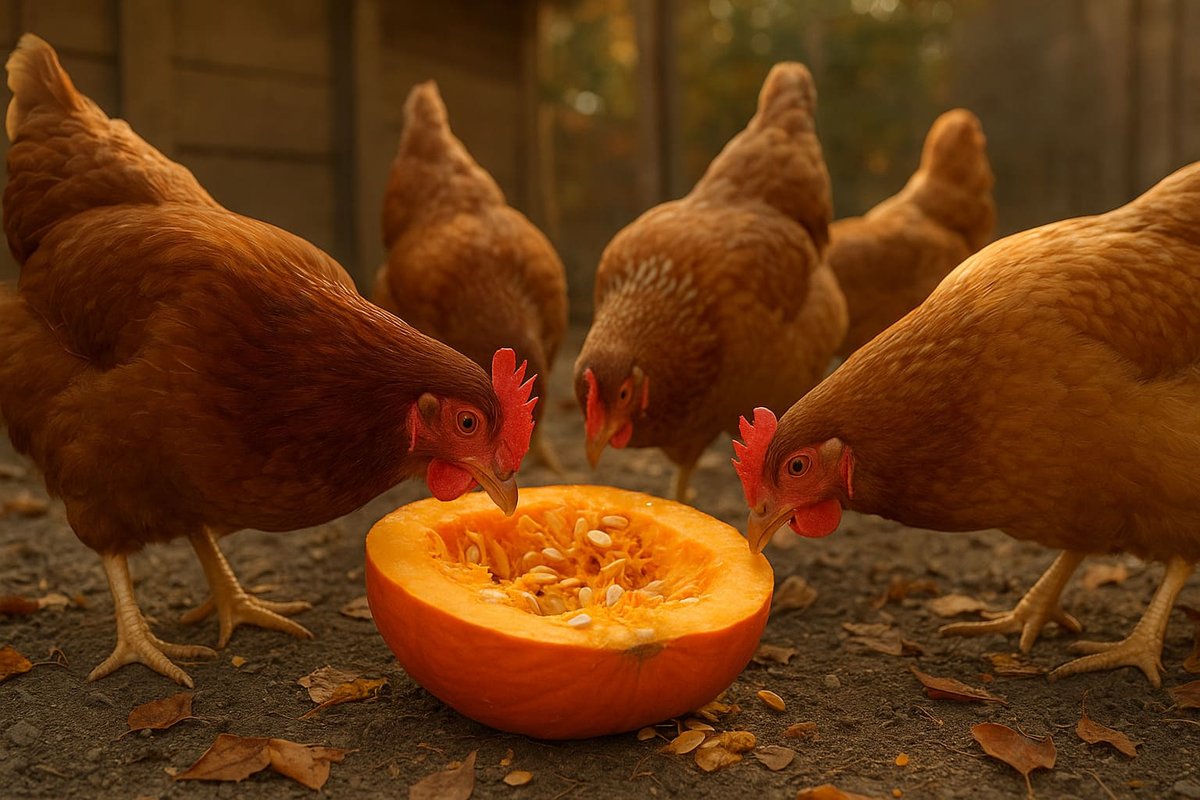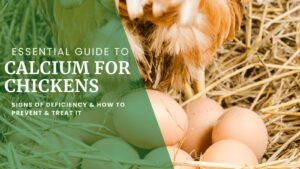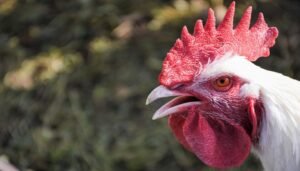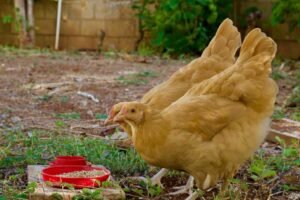Can Chickens Eat Pumpkins? Yes, chickens can eat pumpkins safely, including the flesh, seeds, skin, and guts. This fall favorite is packed with vitamins A, B, C, E, plus minerals like zinc, potassium, and magnesium that support chicken health. Your flock can enjoy pumpkins raw or cooked, whole or cut. Moderation, however, is key- think one pumpkin every other day for a small flock- to maintain a balanced diet. And what about the rumor that pumpkin seeds are a natural dewormer? Trust me, I wondered the same thing when I first started, but the scientific evidence simply does not support this claim for chickens.
After raising backyard chickens for over ten years, I’ve learned that pumpkins are one of the most exciting and nutritious treats you can offer. They are also incredibly cost-effective. Post-Halloween pumpkins are often free or discounted to $0.50-$2.00 per pumpkin, making them one of the most economical what chickens can eat from your kitchen. This guide compiles everything I’ve learned to help you feed this fall superfood safely.
Nutritional Benefits of Pumpkins for Chickens
So, what makes pumpkins such a nutritional powerhouse for poultry? For starters, they are an excellent source of hydration and key nutrients. The vibrant orange flesh is also rich in beta-carotene. When a chicken eats it, its body converts this into vitamin A, which, as the USDA explains, is crucial for overall health. This vitamin boost also contributes to a richer, more vibrant orange egg yolk color. What a bonus!
A Deeper Look into the Nutrients
- Vitamins:
- Vitamin A (from Beta-Carotene): This is crucial for vision, immune response, and reproduction. You can find detailed nutritional data at the USDA FoodData Central.
- B Vitamins, C & E: These help with energy metabolism and combat stress.
- Minerals: Zinc, Magnesium, and Potassium are crucial for feather quality, bone health, and strong eggshells.
- Protein & Healthy Fats: Found mainly in the seeds, these provide a fantastic energy boost, especially beneficial during the colder months.
- Dietary Fiber: The flesh and skin provide dietary fiber, which aids in digestive health.
A Special Boost During Molt
The high protein content in pumpkin seeds makes them an excellent supplement for chickens going through their annual molt. Growing new feathers is a protein-intensive process, and as university guides on feeding laying hens explain, adequate protein is critical during this stressful chicken molting season.
How Does Pumpkin Compare to Other Chicken Treats?
It’s clear pumpkins are a nutritional goldmine. But how do they stack up against other common garden treats?
| Treat | Key Nutrients | Hydration Level | Best For… |
|---|---|---|---|
| Pumpkin/Squash | High in Vitamin A, Protein (seeds), Fiber | High (94%) | All-around nutrition, fall/winter energy, molt support. |
| Watermelon | High in Vitamin C, Lycopene | Very High (92%) | Hot summer days, hydration boost. Less dense in nutrients. |
| Cucumber | Low in calories | Extremely High (95%) | Hydration on the hottest days with minimal caloric intake. |
While watermelon and cucumber are excellent for hydration, pumpkin and other winter squashes offer a much richer nutritional profile, making them a more substantial treat, particularly in cooler weather.
Can Chickens Eat All Parts of a Pumpkin?
Yes, chickens can safely eat all parts of a pumpkin: flesh, seeds, skin (peel), stringy guts, and even the stem if it’s soft enough. Your flock will happily peck away at every part of this winter squash.
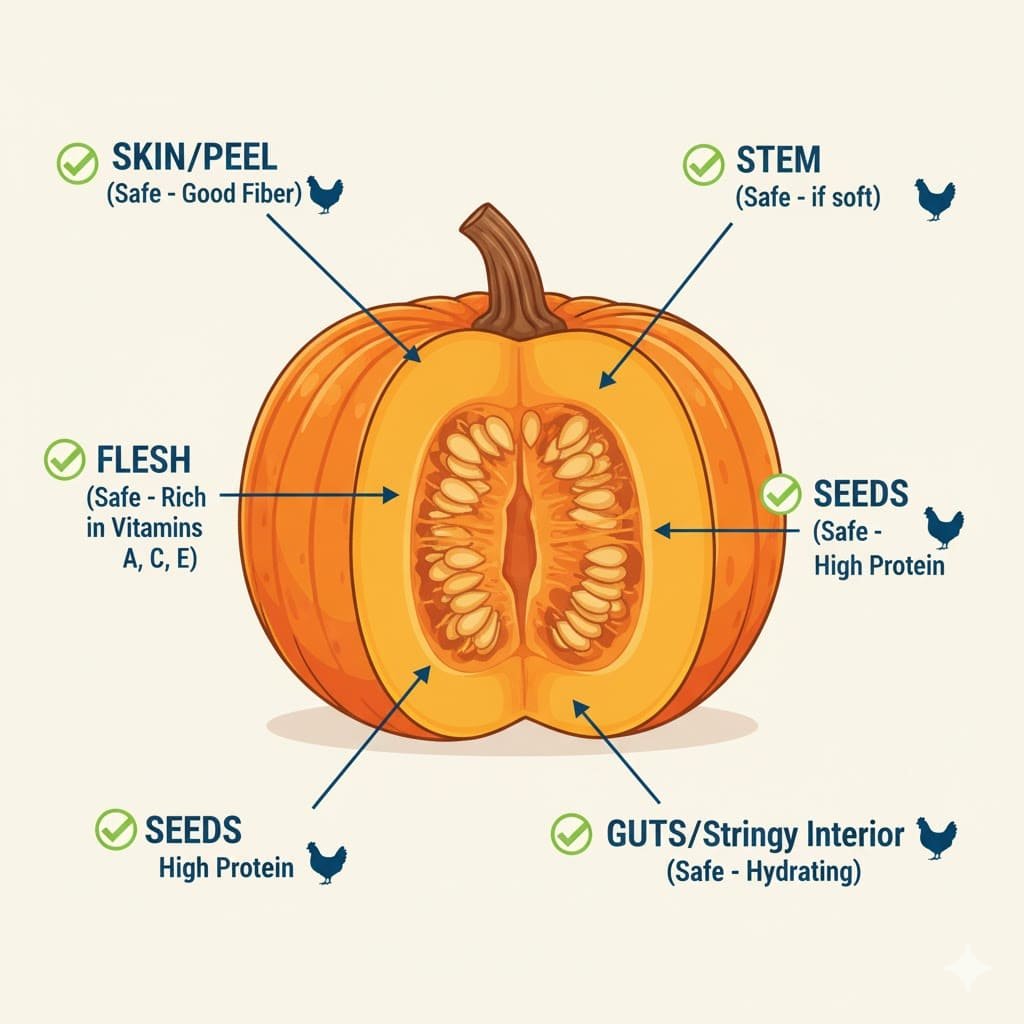
Can Chickens Eat Pumpkin Seeds?
Absolutely. Chickens can eat pumpkin seeds. They are a flock favorite, packed with protein and healthy fats.
Can Chickens Eat Pumpkin Seeds with Shells?
Yes, chickens can and should eat pumpkin seeds with their shells on. A chicken’s gizzard is perfectly capable of grinding up the raw shells, which add extra fiber.
Can Chickens Eat Pumpkin Skin (Peel)?
Yes, they can eat the skin. While the hard outer shell might present a challenge, they will eventually consume the entire pumpkin.
Can Chickens Eat Pumpkin Plants and Stems?
The entire pumpkin plant is edible for chickens, including the leaves and vines. However, it is absolutely critical to ensure the plants are pesticide-free.
Can Chickens Eat Pumpkin Guts?
They love the guts! That stringy, slimy interior is often the first part they’ll devour.
Pumpkin Varieties: Does it Matter Which Kind You Feed?
Chickens aren’t picky, but there are slight differences between pumpkin types.
- Carving Pumpkins (e.g., Howden): These are the big jack-o’-lantern types. They have thinner, watery flesh. They are perfectly safe and what you’ll most likely get for free after Halloween.
- Pie Pumpkins (e.g., Sugar Pie): These are smaller, sweeter, and have thicker, more nutrient-dense flesh. They are a superior nutritional choice if you are buying pumpkins specifically for your flock.
- Ornamental Varieties: Small, colorful gourds and pumpkins are also safe for chickens. They may have tougher skins, but your flock will get through them eventually.
While pie pumpkins are technically more nutritious, any variety of pumpkin is a fantastic and healthy treat.
Can Chickens Eat Raw or Cooked Pumpkins?
Your flock can enjoy pumpkins both raw and cooked. Most keepers find that raw is easier and often preferred.
Raw vs. Cooked Pumpkin for Chickens: A Comparison
| Feature | Raw Pumpkin | Cooked Pumpkin |
|---|---|---|
| Nutritional Value | Maximum nutrient retention. | Slight nutrient loss during cooking. |
| Preparation | Very easy. Just cut open and serve. | Requires extra time for steaming or roasting. |
| Texture | Firm and tough, providing excellent enrichment. | Soft and mushy. Easier for chicks or older hens. |
| Safety | Perfectly safe. | Safe ONLY if plain. No salt, sugar, or oils. |
How to Prepare Pumpkins for Chickens
Preparing a pumpkin for your flock is simple. Your main goal is to make it accessible and safe.
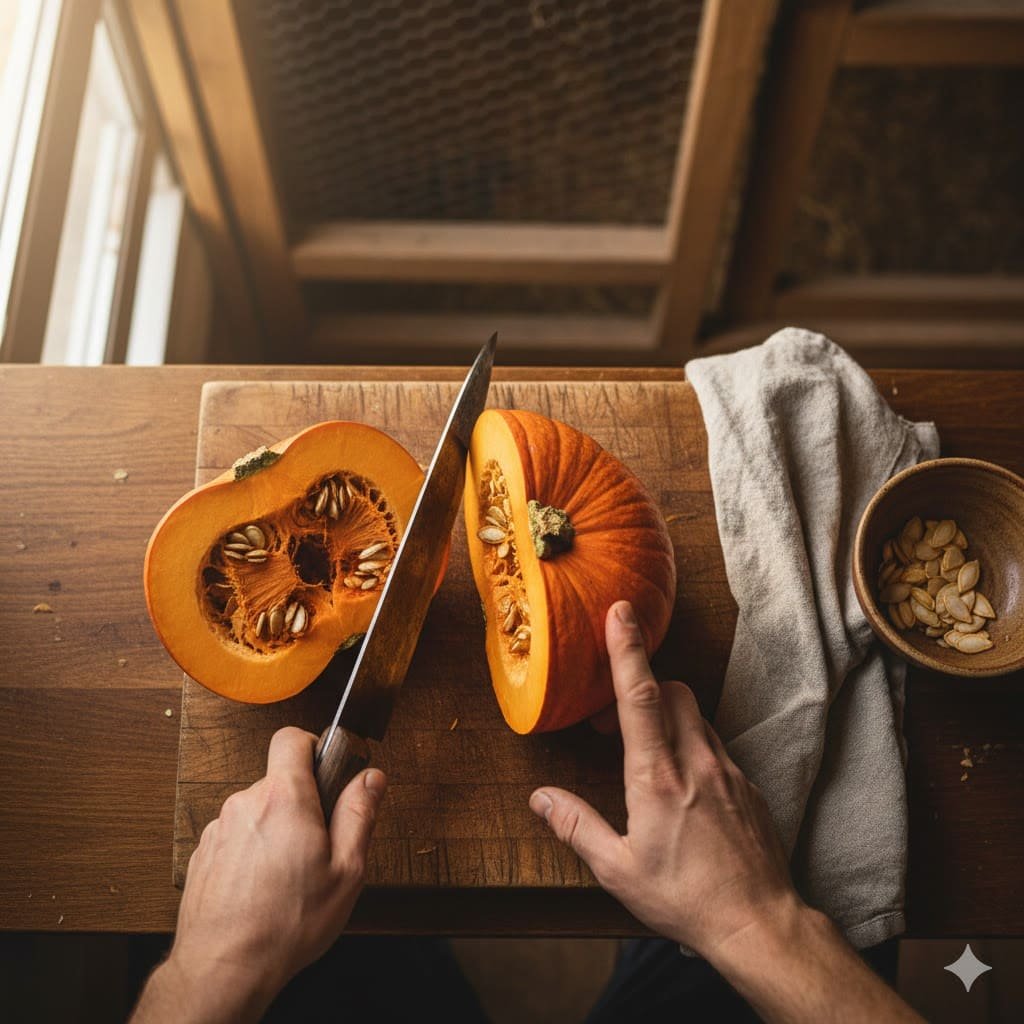
Feeding Whole or Cut Pumpkins
Can I put a whole pumpkin in the chicken coop? Yes, but in my experience, chickens prefer pumpkins cut in half. Here’s a simple guide:
- Inspect the pumpkin. Look for mold or soft spots.
- Remove decorations. Take off any stickers, tape, or glitter.
- Clean carved pumpkins. Thoroughly scrape out any candle wax.
- Cut it in half or quarters to give immediate access to the seeds.
- Place it in the run or coop in a clean area.
- Monitor and remove leftovers after a day or two to avoid attracting pests like rats.
How to Hang a Pumpkin for Chickens
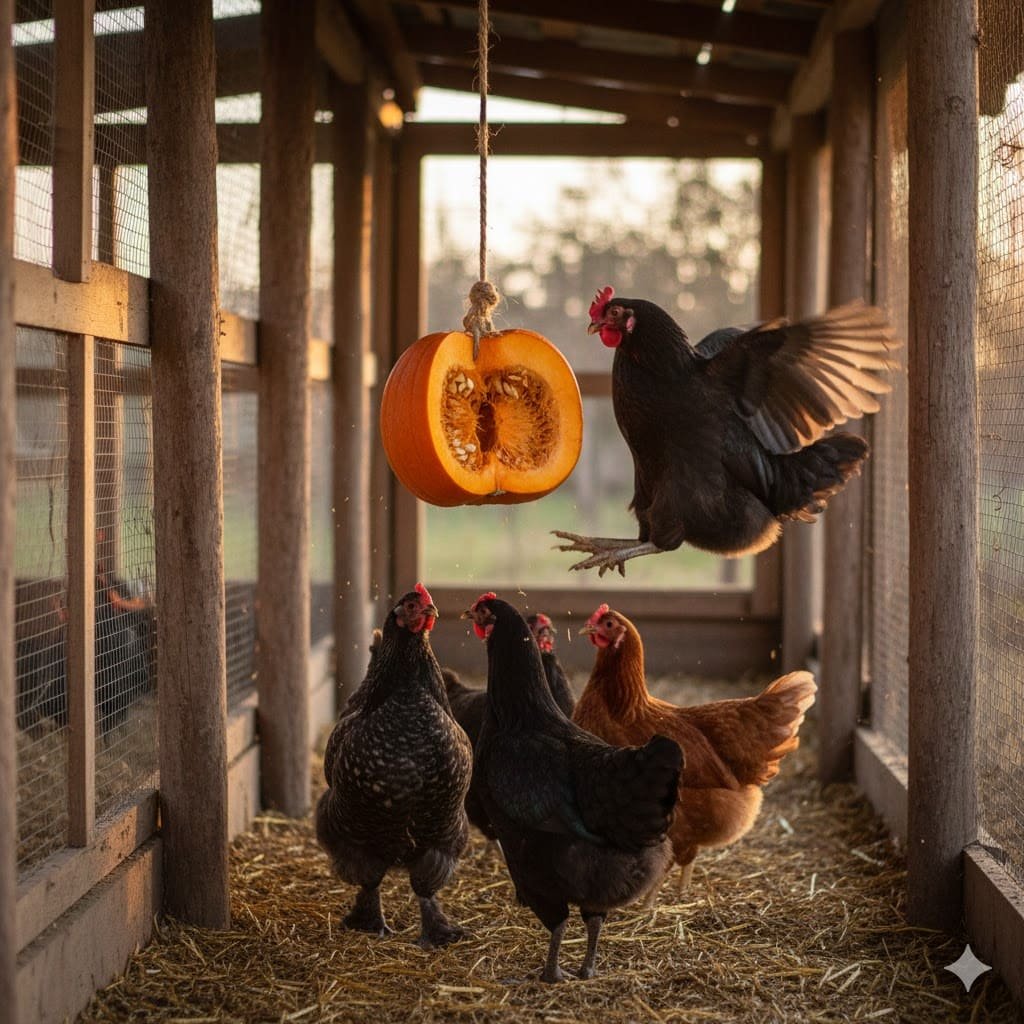
Hanging a pumpkin provides fantastic entertainment for your flock and helps keep the treat clean and off the ground. It’s a great boredom-buster that can reduce feather-picking. Here’s how I do it:
- Cut a small to medium-sized pumpkin in half.
- Drill a hole through the top center of one half, near the stem area.
- Thread a strong piece of twine or rope through the hole and tie a secure knot.
- Hang the pumpkin from a beam in the coop or a sturdy branch in the run, so it dangles just at your chickens’ head height.
They’ll have a blast pecking at their swinging ‘pumpkin piñata’!
How Much Pumpkin Can You Give Chickens?
When it comes to treats, moderation is critical. Remember the 10% rule advocated by poultry experts and university extension programs like Oregon State University: all treats should make up no more than 10% of your flock’s total diet. The other 90% should come from a high-quality, balanced layer feed, which you can make yourself or buy.
Flock Size Feeding Calculations
Here are some more detailed guidelines based on flock size:
- Small flock (4-8 chickens): 1 small pumpkin every 2-3 days.
- Medium flock (8-15 chickens): 1 medium pumpkin every other day.
- Large flock (15+ chickens): 1 large pumpkin can be offered daily, but monitor to ensure they still eat their main feed.
Can Chickens Eat Pumpkins Everyday?
No, chickens should not eat pumpkin every day. While a large flock might consume one daily, a typical backyard flock should only get it a few times a week. Feeding it daily would violate the 10% rule and lead to dietary imbalances, as they’d fill up on pumpkin instead of their formulated feed. You can learn more in this comprehensive guide to feeding chickens.
Do Pumpkin Seeds Deworm Chickens? Scientific Evidence Explained
No, pumpkin seeds are not a proven natural dewormer for chickens. This is a persistent myth, but scientific research has shown it to be ineffective. A peer-reviewed study from Auburn University specifically tested pumpkin seeds on chickens with intestinal worms and found they had no significant deworming effect.
Why the Deworming Myth Persists
The myth stems from a misunderstanding. Pumpkin seeds contain cucurbitacin, which can paralyze worms in a lab setting. However, research from institutions like Ohio State University highlights that these studies use concentrated extracts, not whole seeds. The dosage in raw seeds is far too low to be effective in a live chicken. For effective parasite control, it’s better to focus on a solid poultry farm biosecurity plan and consult a vet about how to properly treat internal parasites and worms.
Seasonal Feeding: When to Offer Pumpkin
- Fall Harvest (September – November): This is the peak season. Pumpkins are fresh, cheap, and plentiful.
- Post-Halloween Bonanza (Early November): The absolute best time for cost-effectiveness. Ask neighbors for their uncarved, unpainted pumpkins.
- Winter Treats (December – February): Use pumpkins you have stored properly. The extra calories and nutrients are especially welcome during cold snaps, which is a key part of winterizing your chicken coop.
Can Chickens Eat Decorative Pumpkins and Jack-O’-Lanterns?
Yes, as long as they are clean and fresh. It’s a fantastic way to recycle, but you have to be careful.
Pumpkin Part Safety and Nutrition Breakdown
| Pumpkin Part | Safe for Chickens? | Preparation Needed | Key Nutrients | Common Concerns & Notes |
|---|---|---|---|---|
| Flesh | Yes | Cut open for easy access. | Beta-Carotene (Vitamin A), Vitamin C, Potassium | Can be fed raw or cooked. Cooked flesh is softer for chicks. |
| Seeds | Yes | None. Feed raw with shells on. | Protein, Zinc, Healthy Fats | They are not a dewormer. Adult chickens handle shells easily. |
| Skin/Peel | Yes | Cutting the pumpkin open is sufficient. | Dietary Fiber | Is the hard skin okay? Yes, chickens will peck at it over time. |
| Guts | Yes | None. Serve as-is. | High Moisture, Nutrients from attached seeds | The stringy part is perfectly safe and a flock favorite. |
Can Baby Chicks Eat Pumpkin?
Yes, but it’s best to wait until they are at least 4-6 weeks old. Cooked, mashed pumpkin flesh (without skin or seeds) is the best way to offer it. The large seeds could pose a choking hazard for very small chicks. When you’re bringing new chicks home, stick to their starter feed for the first few weeks.
How to Store Pumpkins for Winter Treats
- Whole Pumpkins: Store whole, uncarved pumpkins in a cool, dark, dry place. They can last for 2-3 months.
- Freezing Pumpkin: Cook and puree pumpkin flesh, then freeze it in bags or ice cube trays.
- Storing Seeds: Roast plain pumpkin seeds (no salt or oil) until dry and store them in an airtight container for a winter protein boost.
Can Ducks Eat Pumpkins?
Yes, ducks can eat pumpkins, and they love them just as much as chickens do. They enjoy the flesh, seeds, and guts.
Can Chickens Eat Canned Pumpkin?
Yes, your flock can eat plain canned pumpkin, but make sure it is 100% pure pumpkin puree. Avoid pumpkin pie filling, which is full of sugar and spices.
When to Avoid Feeding Pumpkins to Chickens
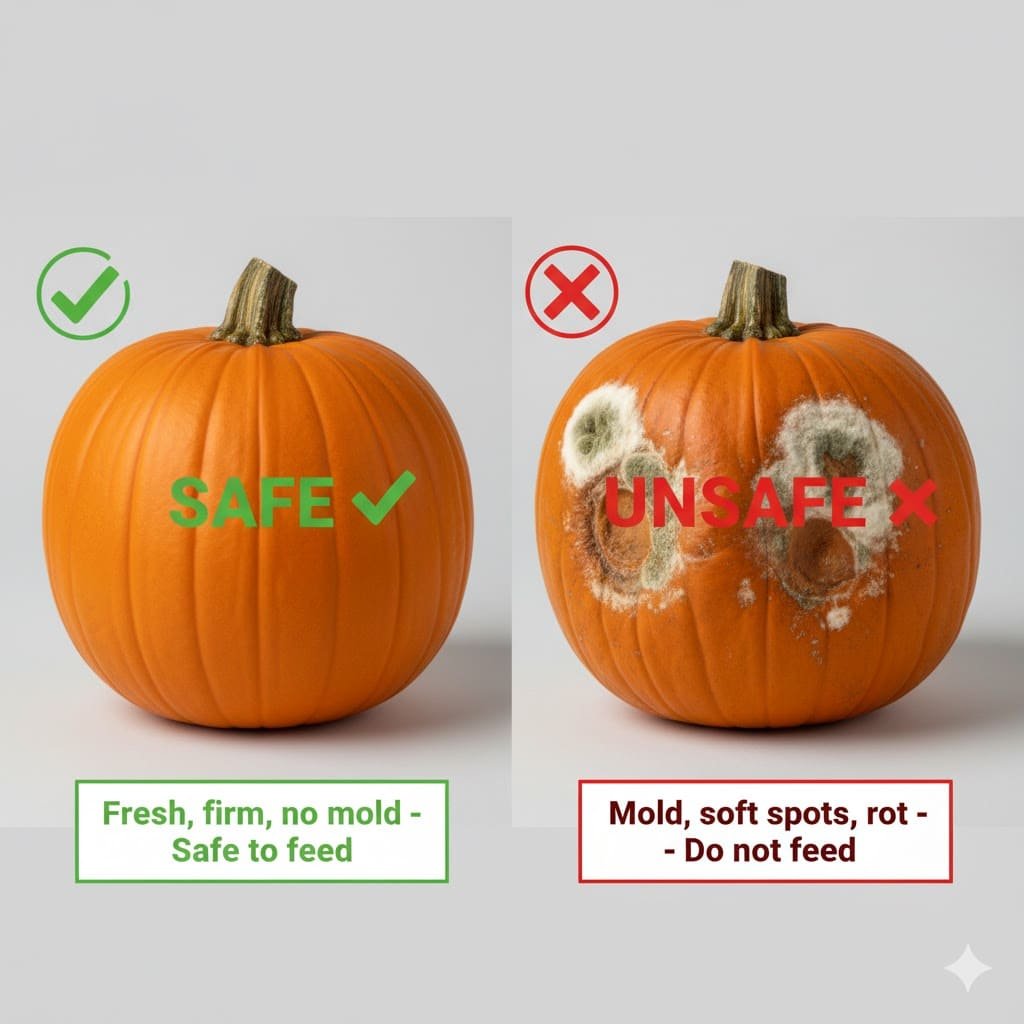
A spoiled or contaminated pumpkin can be dangerous, a fact confirmed by vet-reviewed sources like DialAVet. Your flock’s safety should always be your top priority. NEVER feed a pumpkin if you see any of these signs:
- Moldy pumpkins: Discard them immediately. Mold can produce mycotoxins that are very harmful to chickens.
- Rotting or soft pumpkins: A mushy pumpkin is a breeding ground for harmful bacteria.
- Over-decorated pumpkins: Don’t feed pumpkins with glitter, paint, or other decorations you can’t fully remove.
- Evening leftovers: Remove any uneaten pumpkin from the coop or run before nightfall to avoid attracting rodents.
Pumpkin Feeding Safety Checklist
Before you feed any pumpkin to your flock, run through this quick safety check:
| Safety Check | Is it Safe? (Yes/No) | Why it Matters |
|---|---|---|
| Is the pumpkin fresh and firm? | Yes | Mushy or soft spots indicate bacterial rot, which can make chickens sick. |
| Is there any visible mold (black, white, or fuzzy spots)? | No | Mold produces mycotoxins that are highly toxic to poultry and can be fatal. |
| Has it been painted or decorated with glitter? | No | Craft supplies can contain toxic chemicals, heavy metals, and indigestible plastics. |
| Was it a jack-o’-lantern with candle wax residue? | No | Scrape off ALL wax. Scented candles can contain harmful chemicals. |
| Do you know for certain it is pesticide-free? | Yes (or wash thoroughly) | Pesticide residue can be harmful. When in doubt, it’s safer to avoid feeding the skin. |
| Is it being served in moderation (as a treat)? | Yes | Overfeeding pumpkin can lead to dietary imbalance and digestive upset. |
Final Thoughts: Pumpkins Are a Fall Superfood for Your Flock
Pumpkins are one of the best seasonal treats you can offer your chickens. They’re safe, nutritious, cost-effective, and your flock will absolutely love them. From the vibrant orange flesh packed with beta-carotene to the protein-rich seeds, every part of the pumpkin provides valuable nutrients that support immune health, egg production, and overall vitality.
Remember these key guidelines for safe and effective pumpkin feeding:
- Feed in moderation: One medium pumpkin every other day for a small flock keeps treats at the recommended 10% of their total diet
- All parts are safe: Flesh, seeds, skin, guts, stems, and even leaves are edible when fresh and pesticide-free
- Preparation is simple: Cut in half for easy access, or hang for entertainment and enrichment
- Skip the deworming myth: While nutritious, pumpkin seeds are not a proven dewormer—use proper veterinary treatment for parasite problems
- Inspect before feeding: Always check for mold, rot, or contamination, and remove decorations from jack-o’-lanterns
After more than a decade of raising chickens, I can tell you that few treats generate as much excitement in the coop as a freshly cut pumpkin. The entertainment value alone—watching your flock attack it with enthusiasm—makes it worth offering. Add in the nutritional benefits and the fact that post-Halloween pumpkins are often free, and you’ve got a win-win situation for both you and your birds.
Whether you’re a seasoned chicken keeper or just getting started with your first flock, pumpkins are a simple, safe, and beneficial way to supplement your

Oladepo Babatunde is the founder of ChickenStarter.com. He is a backyard chicken keeper and educator who specializes in helping beginners raise healthy flocks, particularly in warm climates. His expertise comes from years of hands-on experience building coops, treating common chicken ailments, and solving flock management issues. His own happy hens are a testament to his methods, laying 25-30 eggs weekly.
